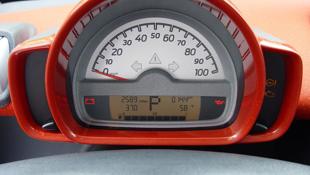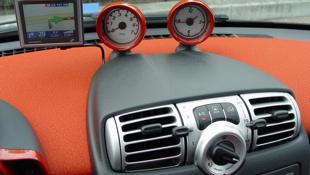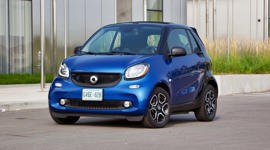Model
2008 to 2015 Smart Fortwo
Vehicle Type
Two-seat microcar
History/Description
Changes to diesel emissions standards meant that for the 2008 model year, Smart had to scrap the diesel engine powering their tiny model and install a gas-powered unit instead. The second-generation model, on our shores, remained similar to its predecessor – with a rear-mounted little engine, rear-wheel drive and an automated five-speed manual transmission.
Look for a coupe or ‘convertible’, which featured a fold-back fabric roof. The ‘Pure’ designation was given to more basic models, with the ‘Passion’ after it. Models in the used market wearing the ‘Brabus’ badge got sporty exhaust, wheels and some extra equipment.
Fully featured, the Fortwo was available with power accessories, automatic climate control, rain sensing wipers, Bluetooth, heated leather, a CD player, cruise control, and more.
Engines/Trim
All units came with a one-litre three-cylinder, packing 70 horsepower and nearly as much torque. The transmission was a unique and often-debated five-speed automated manual, basically utilizing the guts of a manual transmission with mechanisms for automatic shifting without a clutch pedal.
What Owners Like
No surprises with owner likes. The Fortwo is commonly praised for good fuel mileage, good all-around visibility, giggle-eliciting maneuverability, and the uniqueness, exclusivity and attention-grabbing factor built into its funny styling. A pleasing level of luxury feature content and surprising headroom for taller drivers are also noted. Finally, many owners stress that the Fortwo is bigger inside than it looks, offering more passenger volume and cargo capacity than many folks think.
What Owners Dislike
Common gripes centre around a rough and bumpy ride, partially thanks to the Fortwo’s short wheelbase and stiff shocks. Some owners wish for a smoother and more responsive transmission, too.
Here’s a look some owner reviews.
The Test Drive
Start your Fortwo test-drive with a full and complete inspection of all interior electronics. You’ll want to triple check for proper operation of all lights, the stereo system, the horn, the instrument cluster and more. Scattered reports of hard-to-diagnose electrical problems have popped up, possibly caused by lower-than-required battery in some cases. Have a mechanic start diagnosing any electrical gremlins with a check of battery and charging system health.
Numerous owners have reported issues with the climate control fan motor, relating to sporadic operation or total non-functionality. Confirm that the fan in the Fortwo you’re considering works consistently on all speed settings, maintains its speed, and turns on and off every time you engage it. Non-functionality could require a new motor, at a cost of a few hundred dollars, though the owner’s community has some interesting reading for do-it-yourselfers.
Outside the car, check for rust and the overall condition of the vehicle’s paint. Pay special attention to the roof panel on coupe models, which is known to be easily ‘crazed’ when exposed to the elements over time. (Crazing is the development of a series of small cracks in the paint membrane). Some owners have had the panel replaced multiple times – so look closely for this problem. Here’s some more reading. Some owners have reported broken interior sunshades that come off of their track, so confirm proper operation of this accessory, if equipped.
Confirm that all bulbs are in working order, and check all head and taillamp housings for signs of cracking or condensation, both of which could reduce bulb life. Why? Many owners report expensive bills to replace bulbs and light housings when required, because of the labor involved to access the necessary components. One discussion here.
On a test drive, be sure to pay attention to the quality of the gear shifts at all times. The Fortwo’s transmission shifts uniquely to almost anything else on the road, with slow and deliberate shifts. Be on the lookout for unwelcome noises and sensations, like banging or clanking, in the process, though. Slippage is another sign of trouble. If any are detected, the first course of action should be to confirm that all software updates relating to the transmission have been installed. This seems to fix the issue most of the time – though if it doesn’t, a pricey new clutch, clutch actuator, or actuator motor, may be required. If the Fortwo you’re test-driving shifts itself into neutral and illuminates a wrench icon in the instrument cluster, you’ll need a Smart technician to investigate. Here’s some more reading. Note that an update for model year 2009 seems to have addressed issues with faulty clutch plates.
Further, be sure the transmission lever moves cleanly and easily between all of its settings – if not, a faulty shift lever may be to blame. This issue is fairly common, and should be familiar to a Smart mechanic
Check for any check-engine lights or warning codes present, and ensure the Fortwo you’re considering is running properly both at idle and while accelerating lightly and heavily.
You’ll want to have a mechanic inspect the condition of the tires, brakes and suspension too. During this check, have the mechanic pay special attention to the suspension bushings. Note that any unwelcome popping or clunking sounds could indicate a worn-out suspension component, too. Uneven tire wear may be the result of a Fortwo that’s gone out of alignment, which will require attention. Left unattended, a bad alignment may negatively affect handling, safety, and tire life.
Finally, if you’re considering a convertible model, confirm that the power roof operates as expected by running it through its positions several times, noting any binding, strain or warning lights in the process. Be on the lookout for leaks, checking seats and carpeting for signs of moisture and mould, and visiting a garden hose for a good flood-down, just to be safe. Confirming that the rubber weather seal around the roof is intact, plump and free of damage is a good idea, too.
The Verdict
It’s a quirky little car that’s not for everyone – but the Smart Fortwo has found countless loving owners over the years. Primary reasons to consider one will centre around uniqueness and maneuverability, not all-out reliability and low running costs. If you’re set on a Fortwo, be sure to have a Smart technician give the model you’re considering a full check-over before your purchase, and ensure all software updates have been applied, for maximum peace of mind. A 2009 or later model should be free of any issues with the clutch or its associated actuators, so shop as new as your budget allows.
Here’s some additional reading
A single recall
Crash Test Ratings
IIHS: 2014 Smart Fortwo






























